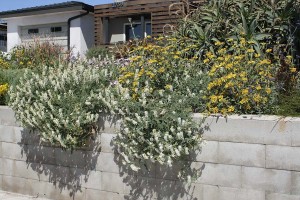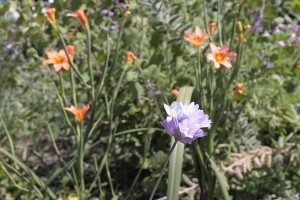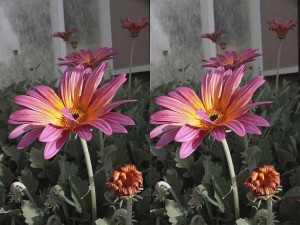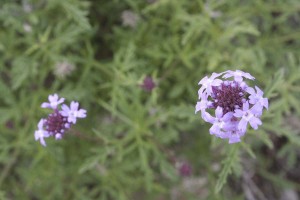Yellow, white, blue, lavender, pink…The front garden is crazy strident right now and I like it. The floral chaos is concentrated along the sidewalk in front of the house, where the plants present themselves at eye-level for anyone walking by.
If you were to check passports on the plants you’d find a number of California origin mixed in with others from Mediterranean climates. Here’s the gloriously sprawley Nuttall’s milkvetch, Astragalus nuttallii, from the California Central Coast, with a South African arctotis hybrid.
The deep violet chia, Salvia columbarae, hails from around here. The bright yellow Jerusalem sage, Phlomis monocephala, from Turkey. The chia is annual but reseeds itself efficiently. After the plant dies back, its seed heads stay attractive for several months. The phlomis starts to drop its leaves in summer’s drought but never goes entire bare. As it does that, the leaves turn more and yellowish- grayish-green in color.
To help control the floral chaos, I’ve planted incorporated a lot of each of these two plants, along with several of the milkvetch above.
The locally common bulb, blue dicks, Dichelostemma capitatum, with the salmon colored South African bulb, Homeria collina behind it.
A yellow crassula picks up on the yellow theme as you walk by.
A couple years ago I broadcast some seed of Southern California’s Phacelia parryi but never saw any make it to maturity. Just a week ago I noticed this, one of the last flowers on a small plant that has come up from that old broadcast. I probably would have missed it if it weren’t up at eye-level.
I tried shooting a walk-by encounter of the front garden using my cellphone’s camcorder feature. Unfortunately the result looks like it was shot with a, well, cellphone, and I’m too embarrassed to share it. Too bad. Gardens are best explored in time and space and not in still photos. Videos could give you a sense of exploration still photos can’t. Well, I love a project, and getting a decent walk-by sequence will be another item on my ever-growing punchlist.





























